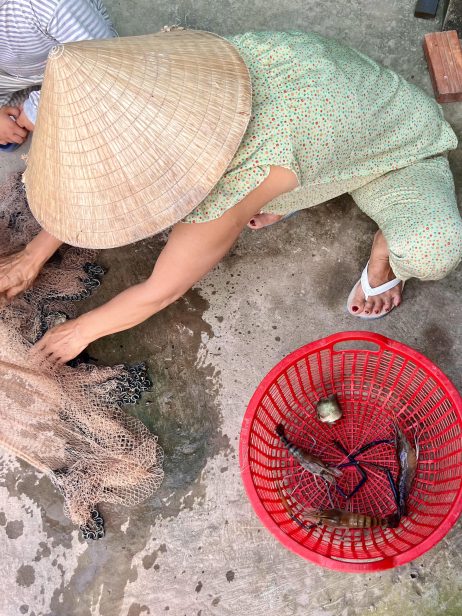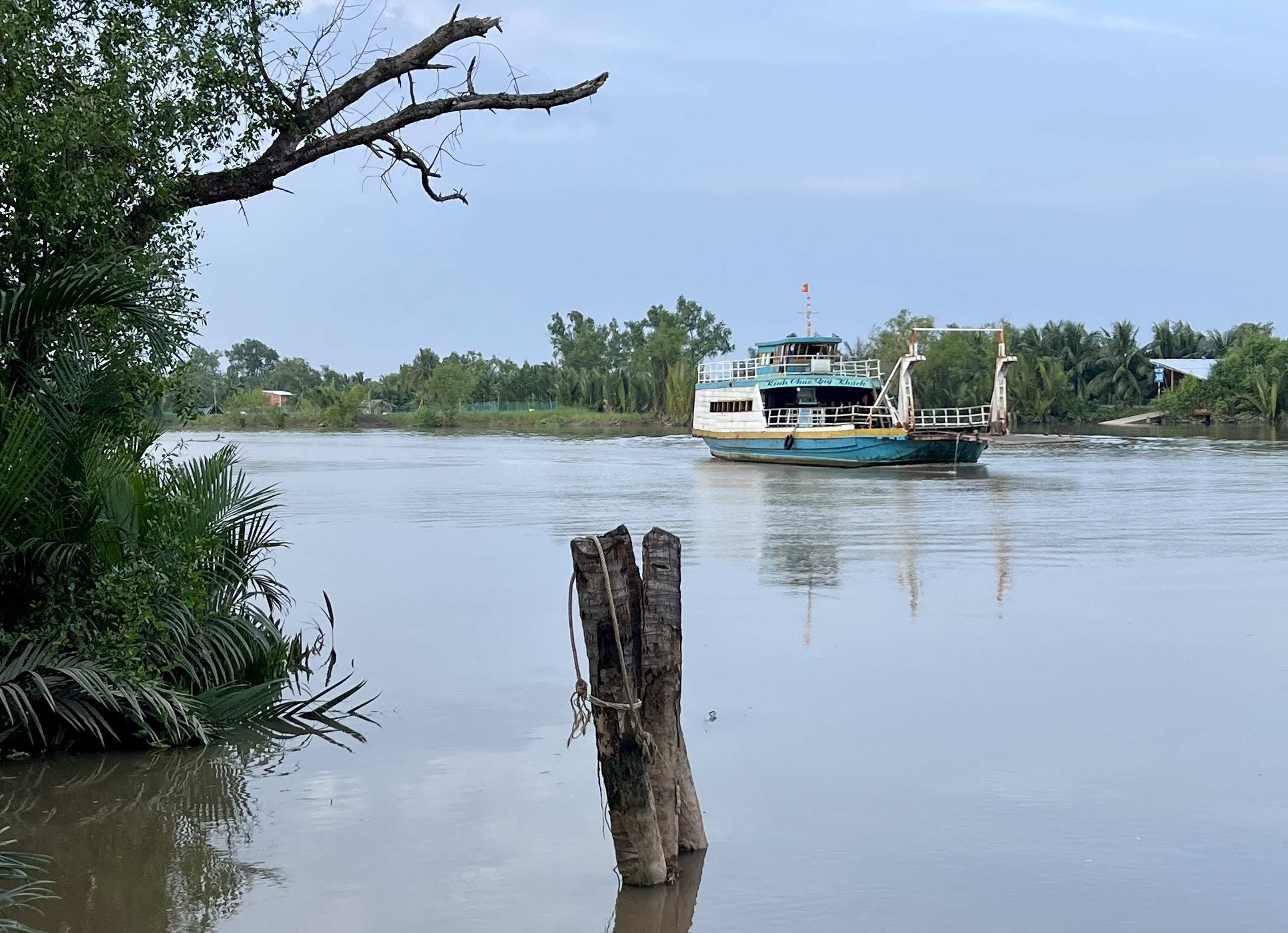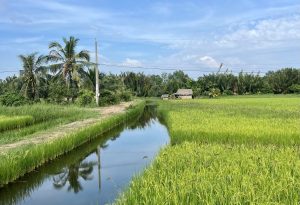In the delta region of South Vietnam, where the Mekong River flows into the South China Sea, locals fear that their mother is dying. They see her banks swell and collapse; salt infiltrates higher and farther than it ever has before. The Mekong is sinking.
The Mekong River stretches for 4,350 kilometers, flowing from Tibetan glaciers through six countries and eventually through Vietnam to the sea. The river’s name comes from Mae Nam Khong, a Thai and Lao phrase meaning “Mother Water.” This is fitting, as it brings vital resources to more than 70 million people across mainland Southeast Asia. The Mekong’s banks have historically provided perfect conditions for rice production, with the southern delta provinces affectionately named the “rice basket” of Vietnam.
Now, climate change and environmental degradation from human development present an existential threat to the Mekong. Salt intrusion into the freshwater river, rising sea levels, land subsidence, sand mining, lower base flow, and upstream damming have all contributed to a decline in agricultural productivity in recent years. In 2020, rice farmers in the provinces most impacted by saline intrusion were expected to lose at least 30 percent of their harvest from lack of fresh water.
Recently, international organizations and government programs have encouraged agricultural diversification toward greater economic and climate resilience. For many, this manifests as maintaining traditional rice paddies in the wet season, when the Mekong can provide enough fresh water to sustain the crops, and then transitioning those same fields to shrimp or prawn farms in the dry season. Having shown initial success, this specific model is being touted as a textbook adaptation “win” in the Mekong Delta region.
Unfortunately, little attention has been paid to the negative environmental impacts of this mass transition to shrimp farming, an ultimately unsustainable move.
An Ancient River Cycles From Life Giver to Liability
For more than a century, the Mekong delta has been a space of global contestation, with Vietnamese governments and other outside powers treating it both as a desirable resource and a battleground. French colonial perspectives that prioritized “mastery over nature” through extensive hydraulic works and the heavy-handed American use of tactical arsenic- and dioxin-based herbicides during the Vietnam War predisposed the Mekong Delta to great environmental vulnerability, for which few international powers have taken responsibility.
Coupled with present day mismanagement, government corruption, and developmental errors, the Mekong is ill-equipped to adapt. The appearance of the delta has changed dramatically over the centuries, during which time it has seen rapid urbanization, agricultural intensification, and devastating environmental destruction. Recently, Vietnamese Prime Minister Pham Minh Chinh, addressing the country’s National Assembly, said that the greatest concerns in the Mekong delta region were land subsidence, landslides, drought, and saltwater intrusion.
Land subsidence refers to the decompression of the land from the weight of infrastructure and/or destabilizing impacts of depleting ground water. This hinders drainage, leading to flooding and increased erosion. Saltwater intrusion refers to the contamination of fresh water sources as saline water is able to flow further upstream. This natural phenomenon has presented a significant issue in the Mekong delta, one that is being worsened by illegal sand mining and impediments to river discharge from upstream dams, combined with downstream sea level rises and intense storm surges.
Pointing the Finger: Climate Change or Environmental Degradation?
There is an interesting dichotomy within this framing. In North Vietnam, where the central government resides, and within much international discourse, the greatest threat to Mekong ecosystems is climate change. However, in the South, and among those worst hit by the changing environment, the problem is environmental degradation that has been directly caused by development and exploitation practices like illegal sand mining and unregulated fishing.
When it comes to climate change, Vietnam can see itself as a passive victim. The country contributes just 0.8 percent of global greenhouse gas emissions, yet suffers from both the current and historical decisions and emissions of the Global North (and neighboring China). In contrast, environmental degradation refers to Vietnam’s active abuse of its ecosystems through unregulated extraction, contamination inputs, and rapid, unsustainable development as the government prioritizes economic growth, and achieving the status of a middle income country by 2030, over the environment.
While Vietnam has pledged to become carbon neutral by 2050, its greatest emissions come from the energy sector. Numerous environmental activists and civil leaders, critical of Vietnam’s contradicting priorities, have been recently arrested and jailed on tax evasion charges. While the country’s increased attention to climate mitigation and adaptation internationally reflects an acute awareness of the economic costs of unsustainable resource exploitation, those who voice concern over Vietnam’s heavy energy sector reliance on coal (49.7 percent) justifiably fear arrest.
This illustrates the tense atmosphere that surrounds the questions of environmental education and transparency in Vietnam, which in turn taints agricultural transition and climate policies. This will ensure further ecosystems damage while making long-term adaptation more difficult.

A farmer removing shrimp from a cast net. The shrimp were caught in her pond for guests visiting her farmstay on Con Chim Island, Tra Vinh. Photo by Quinn Goranson.
Profit and Loss: The Economics of “Sustainable” Development
While the funding landscape in the Mekong delta remains fragmented, especially regarding agricultural issues, farmers and research institutes like Can Tho University are receiving support from the International Fund for Agricultural Development, United Nations Development Program, and bilateral aid from countries like Japan, South Korea, Australia, and the Netherlands. Much of this funding supports delta-wide adoption of new livelihood models, including the prawn rice rotational crop (PRRC) model.
The PRRC model sees farmers plant and harvest their rice crops during the wet season, when the Mekong is abundant with fresh water, and transition to crops that are not adversely impacted by salt water in the dry season, when saline intrusion creeps up into the delta. Shrimp are the most common aquaculture crop, as they can survive salinities of up to 45 grams per liter.
In 2020, when saline water intruded as much 40 kilometers inland, and lingered for months longer than expected in the dry season, 240,000 hectares of rice crops were destroyed. Since this disaster, some farmers have transitioned to exclusively farming shrimp, as 45 percent of the agricultural land in the Mekong Delta region now experiences salinity levels well above 4 g/l, the average upper tolerance for rice crops.
The government in Vietnam has encouraged this transition, and initial research has described these models as climate successes. One riparian province, Bac Lieu, is aiming to increase its shrimp production to $1.3 billion in exports alone by 2025, transitioning the industry toward a 95 percent contribution of its total export revenue by that date. Reports show that on average, through rapid industry and export expansion, PRRC farmers see 65 percent higher annual profits than traditional rice farmers.
Studies of these transitions exclusively focus on economic drivers and adaptive capacity instead of long-term environmental impacts.
The True Costs of Lucrative Agricultural Transitions
Shrimp cultivation is not only far more resource intensive than rice farming; it also produces significantly more greenhouse gas emissions at 13 kilograms of CO2e per kg compared to 0.9 kg of CO2e for rice. Many farmers are still using low-efficiency, high energy-intensity paddlewheel aeration systems to manage shrimp pond water quality, which often fare better at introducing disease-carrying airborne particles than distributing oxygen and nutrients. In larger, non-organic farms, chemicals and antibiotics are used to prevent disease and increase yields, causing groundwater contamination and runoff that taints organic aquaculture ponds and the surrounding ecosystem. PRRC farmers have begun noticing the long-term impacts of shrimp ponds on soil quality, as climate change limits the capacity of the Mekong to flush out the salt, making the land less fertile.
Eventually, as saline intrusion worsens from continued sea level rise and ground subsidence, salinity levels will surpass that which is tolerable even to these shrimp species. This observation has encouraged groundwater extraction to dilute the salinity levels of the shrimp ponds. Aquifer depletion has contributed to land subsidence cross the Mekong delta for decades, accelerating delta sinking to an unprecedented rate at 18 centimeters over the last 25 years. This perpetuates a negative feedback loop where saline intrusion encourages agricultural diversification into shrimp aquaculture, depleting the aquifer below the delta. This further contributes to land subsidence, one of the key initial drivers for saline intrusion.

A ferry along the Cổ Chiên River, a tributary of the Mekong, in the Delta province of Tra Vinh. This boat brings tourists from the banks of Tra Vinh City to Cồn Chim Island. Photo by Quinn Goranson.
Moving Forward: Putting the Needs of the Ecosystem at the Center
Further studies are needed to better understand impacts on the Mekong delta’s ecosystem. Currently, proposed climate adaptation policies that encourage drastic agricultural transitions to models like PRRC, while being more profitable, are not environmentally sustainable over the long term. Though difficult, it is important for local governments and the international community to acknowledge the dissonance between dual priorities. Given the existential threats facing the Mekong rice basket, teetering between priorities of economic prosperity and environmental survival, policy alternatives for more sustainable agriculture must be explored.
Some bright spots in agricultural development come from Tra Vinh University, which has conducted research into Alternate Wetting and Drying technology, which allows for traditional rice production using 20 percent less water. Likewise, in the aquaculture sector, companies like Rynan Technologies are developing innovative solutions to nutrient supply and energy intensity with their Pressure Swing Adsorption Unit.
Through policy implementation, research and development, and investment in local initiatives, Vietnam may be able to achieve the concomitant goals of economic growth and climate resilience, while diversifying and intensifying its agricultural sector. But we must remember that the water of the Mekong is the vital thread that knits together all life along the river: respect and humility in the presence of such a great life-giving force should guide all pursuits.

































